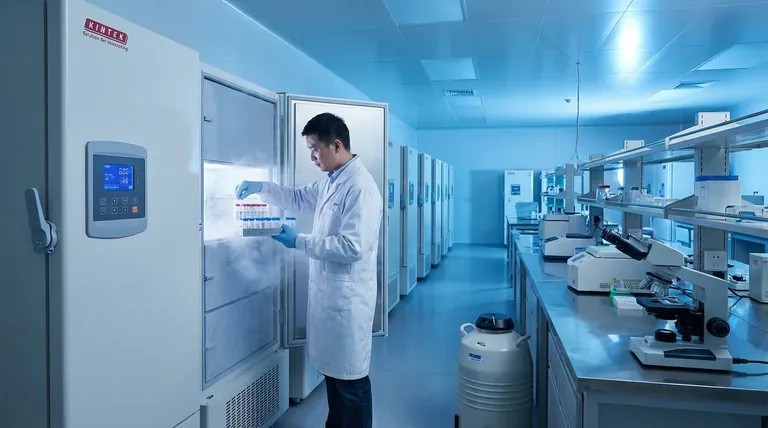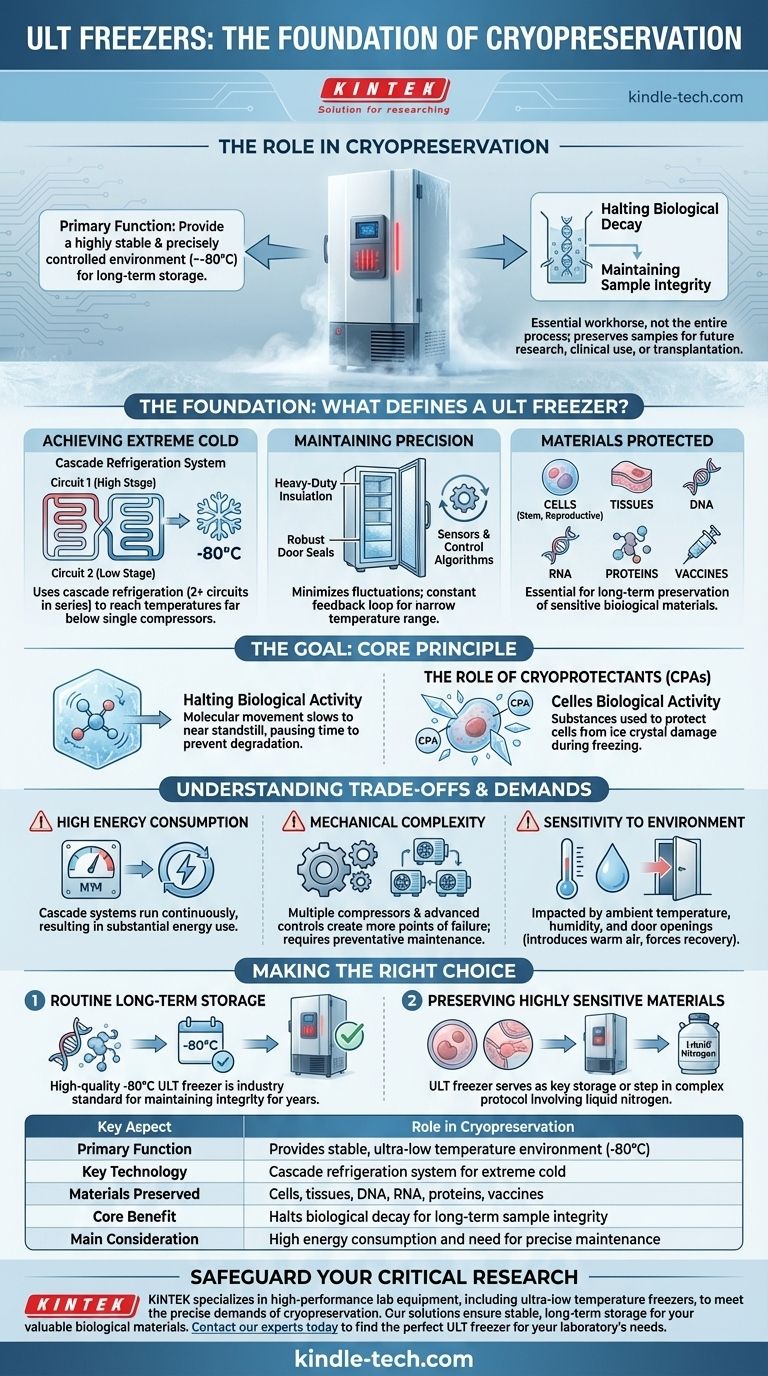In the field of cryopreservation, an ultra-low temperature (ULT) freezer's primary role is to provide a highly stable and precisely controlled environment, typically around -80°C, for the long-term storage of biological materials. While the full process of cryopreservation may involve cryoprotectant agents and even lower temperatures like those of liquid nitrogen, the ULT freezer acts as the essential workhorse for maintaining the viability and integrity of samples for extended periods.
The ULT freezer is not the entire cryopreservation process itself, but rather a critical piece of infrastructure within it. Its function is to halt biological decay by maintaining a consistent, ultra-low temperature, ensuring samples are preserved for future research, clinical use, or transplantation.

The Foundation: What Defines an Ultra-Low Temperature Freezer?
To understand the ULT freezer's role, it's important to recognize that it is a highly specialized piece of engineering designed for a single purpose: extreme, stable cold.
Achieving Extreme Cold
Standard freezers use a single compressor system. A ULT freezer, however, typically uses a cascade refrigeration system, which employs two or more refrigeration circuits in series.
This design allows the system to reach temperatures far below what a single compressor could achieve, reliably holding setpoints at -80°C or even lower.
Maintaining Precision and Stability
Achieving the cold is only half the battle. A ULT freezer is built with heavy-duty insulation and robust door seals to minimize temperature fluctuations.
Internally, sensors and control algorithms create a constant feedback loop, monitoring the temperature and adjusting the refrigeration system to keep it within a very narrow range.
The Materials It Protects
These freezers are essential for the long-term preservation of a wide range of sensitive biological materials.
This includes cells (like stem or reproductive cells), tissues, DNA, RNA, proteins, and critical biopharmaceuticals like vaccines.
The Goal: The Core Principle of Cryopreservation
Cryopreservation is the practice of preserving biological materials by cooling them to very low temperatures to stop all vital biological activity, including the biochemical reactions that lead to cell death and decay.
Halting Biological Activity
At the ultra-low temperatures provided by a ULT freezer, molecular movement slows to a near standstill. This effectively pauses time for the sample, preventing degradation and preserving it in a state of suspended animation.
The Role of Cryoprotectants
A major challenge in freezing is the formation of ice crystals, which can damage and destroy cell structures.
Cryopreservation protocols often use cryoprotective agents (CPAs), which are substances that help protect cells from this damage during the freezing and thawing process.
Understanding the Trade-offs and Demands
While indispensable, ULT freezers come with significant operational considerations that are critical for any facility to manage. Their specialized nature creates specific challenges.
High Energy Consumption
The cascade refrigeration systems required to maintain -80°C are complex and run continuously. This results in substantial and constant energy consumption, making them one of the more power-intensive pieces of equipment in a typical lab.
Mechanical Complexity
With multiple compressors and advanced control systems, ULT freezers have more potential points of failure than standard refrigeration units. Regular preventative maintenance is essential to prevent catastrophic failures that could lead to the loss of irreplaceable samples.
Sensitivity to Environment
The performance of a ULT freezer can be impacted by ambient room temperature and humidity. Furthermore, every door opening introduces warmer, moist air, forcing the system to work hard to recover its setpoint and potentially creating internal frost buildup.
Making the Right Choice for Your Goal
The ULT freezer is a component within a broader preservation strategy. Your specific goal determines how it is best utilized.
- If your primary focus is routine long-term storage of DNA, proteins, or certain cell lines: A high-quality -80°C ULT freezer is often the industry standard and is sufficient for maintaining sample integrity for years.
- If your primary focus is preserving highly sensitive materials like reproductive cells or tissues for transplantation: The ULT freezer often serves as a key storage solution or as a step in a more complex protocol that may ultimately involve liquid nitrogen for the deepest possible freeze.
Ultimately, understanding the specific role of the ULT freezer allows you to implement a preservation strategy that safeguards the irreplaceable value of your biological materials.
Summary Table:
| Key Aspect | Role in Cryopreservation |
|---|---|
| Primary Function | Provides stable, ultra-low temperature environment (-80°C) |
| Key Technology | Cascade refrigeration system for extreme cold |
| Materials Preserved | Cells, tissues, DNA, RNA, proteins, vaccines |
| Core Benefit | Halts biological decay for long-term sample integrity |
| Main Consideration | High energy consumption and need for precise maintenance |
Safeguard your critical research and clinical samples with reliable ULT freezers. KINTEK specializes in providing high-performance lab equipment, including ultra-low temperature freezers, to meet the precise demands of cryopreservation. Our solutions ensure the stable, long-term storage your valuable biological materials require. Contact our experts today to find the perfect ULT freezer for your laboratory's needs.
Visual Guide

Related Products
- 408L Advanced Vertical Laboratory Ultra Low Temperature Freezer for Critical Research Material Preservation
- 508L Advanced Vertical Ultra Low Temperature Freezer for Critical Laboratory Storage
- 58L Precision Laboratory Ultra Low Temperature Upright Freezer for Critical Sample Storage
- 158L Precision Vertical Ultra Low Freezer for Laboratory Applications
- 808L Precision Laboratory Vertical Ultra Low Temperature Freezer
People Also Ask
- In what fields are ultra low temperature freezers most commonly used? Essential for Biomedical, Clinical, and Research Labs
- What are the common designs of ultra-low temperature freezers? Upright vs. Chest Models for Your Lab
- What advantages do ultra-low temperature freezers offer? Ensure Long-Term Sample Integrity and Reliability
- What are ultra low temperature freezers used for? Preserving Critical Biological Samples for Decades
- What is the price range for ultra low temperature freezers? Protect Your Samples with the Right Investment



















